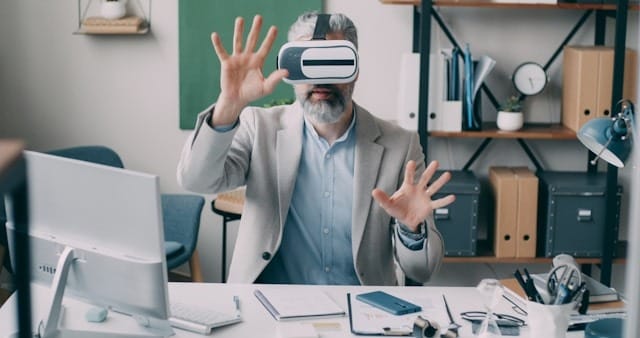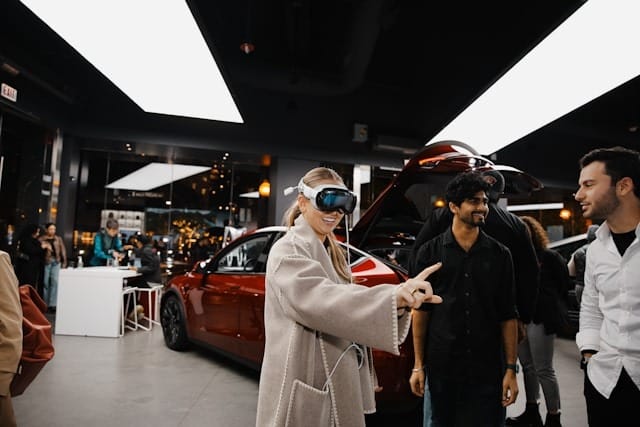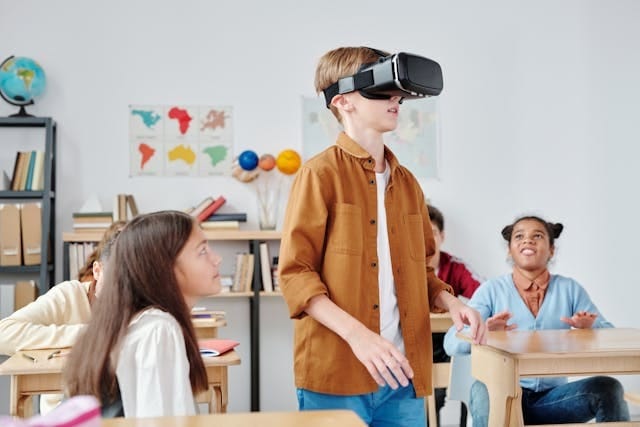Augmented Reality in Business: Enhancing Customer Experience
Imagine a customer trying on clothes without entering a fitting room, or an engineer repairing machinery with real-time guidance from an expert thousands of miles away. These are a few of the many practical examples of Augmented Reality in business today. Augmented Reality blends digital content with the physical world, allowing you to visualize products, improve communication, and train teams more effectively.
In this article, we will discuss why Augmented Reality is becoming essential for every business, how it's being used today, and practical ways to integrate it into your strategy.
Why Augmented Reality in Business?
Augmented Reality provides practical solutions that directly improve your operational efficiency, customer experience, and employee performance. Here's how:
Enhanced Visualization
AR overlays digital information onto real environments, helping you visualize products, processes, or layouts in real time. For example, architects use AR to project 3D building models on-site, allowing clients to see the final design before construction begins. Similarly, retailers use AR to let customers "try on" products virtually, boosting engagement and reducing returns.
Better Communication
Traditional presentations or manuals often limit how you convey complex ideas. With AR, you can present interactive 3D models or real-time annotations that make information easier to understand. This enhances communication among teams, clients, and stakeholders, especially in sectors such as manufacturing, construction, and education.
Remote Expertise
AR enables real-time collaboration between on-site employees and remote experts. Using AR headsets or mobile devices, remote specialists can see what the worker sees and guide them with digital annotations. This minimizes travel costs, speeds up troubleshooting, and ensures consistent service quality.
Improved Service
Customer support teams use AR to provide interactive assistance. For instance, an AR app can guide customers step-by-step through setting up a device or resolving issues without needing an on-site technician. This leads to faster problem resolution, reduced downtime, and increased customer satisfaction.
Flexible Training
AR delivers immersive, hands-on training experiences that traditional methods can't match. Employees can practice complex procedures in a risk-free environment. For industries like healthcare, aviation, or manufacturing, AR-based training significantly improves retention rates and reduces errors.
How Is Augmented Reality Used in Business
Businesses use AR to address real-world problems, streamline workflows, and engage audiences in innovative ways. Here are some core applications:
Product Visualization: AR enables customers to see how products fit into their environment, leading to more informed purchasing decisions.
Marketing and Branding: Brands use AR campaigns to offer immersive experiences, thereby enhancing user engagement and conversion rates.
AR Cloud Technology: This enables persistent digital content tied to real-world locations, allowing for large-scale, multi-user experiences.
AI in Augmented Reality: Artificial intelligence enhances AR by enabling object recognition, personalization, and predictive insights.
Operations Optimization: Companies utilize AR to support maintenance, logistics, and quality assurance, thereby enhancing efficiency and accuracy.
How to Implement AR in Your Business Strategy
Adopting Augmented Reality in business requires a structured approach. To achieve a measurable impact, you must align AR solutions with your goals, resources, and customer needs. Here's a practical roadmap:

1. Define Clear Objectives
Start by identifying specific problems or opportunities that AR can address. For example, do you want to improve employee training, increase online sales, or enhance customer support? A clear objective ensures your investment in AR solutions for business is purposeful and measurable.
2. Evaluate AR Technologies
Explore available tools and platforms, including AR cloud technology, AI-enabled AR systems, and industry-specific applications. Evaluate which mobile-based AR, AR glasses, or mixed reality devices best fit your operational environment.
3. Integrate with Existing Systems
AR shouldn't operate in isolation. Integrate it with your existing software, such as CRM systems, e-commerce platforms, or manufacturing workflows, for a seamless experience. This integration ensures data flows smoothly between AR interfaces and business processes.
4. Develop Pilot Projects
Start with a pilot program to validate your strategy. Choose a single use case, such as AR-based product visualization or remote support, and test it on a small scale. Gather user feedback, measure KPIs, and refine the implementation before scaling up.
5. Train Your Team
Your employees must understand how to use and manage AR tools effectively. Provide structured training, emphasizing both technical skills and customer interaction. AR adoption works best when your team is confident and empowered.
6. Monitor, Measure, and Optimize
Regularly analyze performance metrics such as customer engagement rates, conversion improvements, or training time reductions. Use insights to optimize your AR strategy over time, ensuring sustained value and competitive advantage.
How Businesses Use Augmented Reality?
Businesses across various industries are utilizing Augmented Reality use cases to enhance operations, improve experiences, and unlock new revenue streams. Here's how various sectors are applying AR today:
Retail & E-commerce
In retail, AR transforms how customers shop online and in-store. Virtual try-on features enable shoppers to see how products look on them, ranging from clothing to cosmetics. Furniture retailers use AR to project products into a buyer's home through their smartphone camera, increasing buyer confidence and reducing return rates.
Example: Gucci leveraged Snapchat's AR try-on lenses to let users virtually try on shoes (and other items) through their phones
Manufacturing
AR in retail and manufacturing is revolutionizing workflows. In manufacturing, AR assists technicians with assembly, maintenance, and quality control by overlaying digital instructions onto physical components. Workers can access step-by-step guidance, reducing errors and downtime. Real-time data visualization through AR glasses also enhances efficiency and safety on the shop floor.
Example: Boeing uses AR-guided instructions for aircraft wiring, cutting production time by 25%
Healthcare
Healthcare professionals use Augmented Reality to visualize complex anatomy, plan surgeries, and train medical students. Surgeons can overlay 3D scans on a patient's body during operations for more precise procedures. AR is also used for patient education, improving understanding of treatments and outcomes.
Example: Stanford Medicine uses AR headsets to project live imaging data during surgery, improving precision.
Automotive

AR plays a key role in design, prototyping, and customer engagement in the automotive industry. Engineers use AR to visualize new vehicle designs in real space, allowing faster iteration. Showrooms offer AR experiences where customers can explore vehicle interiors and customize features virtually, increasing sales conversion.
Example: BMW launched an AR visualizer that lets users explore BMW i3 and i8 in life-size 3D, open doors, inspect the interior, and customize colors & trims.
Entertainment
In entertainment, AR enhances live events, gaming, and storytelling. Musicians and filmmakers use AR to create immersive experiences for audiences. Sports broadcasters overlay real-time stats and graphics onto live games, enriching viewer engagement.
Example: Tiffany & Co. launched AR mirrors at the US Open, letting visitors virtually try on digital jewelry.
Military
The military uses AR for battlefield visualization, situational awareness, and advanced training. Soldiers use AR headsets to receive real-time navigation data, threat information, and tactical overlays, thereby enhancing decision-making under pressure.
Example: US Soldiers use AR-equipped helmets for navigation and real-time threat identification.
Travel
AR enhances tourism by providing interactive guides, translations, and cultural information layered over real-world locations. Museums and historical sites utilize AR apps to give visitors immersive storytelling experiences, making learning more engaging.
Example: AR City Tour overlays historical and cultural information when users point their device at landmarks.
Education

Educational institutions adopt AR to create interactive, hands-on learning experiences. Students can explore complex subjects, such as anatomy, astronomy, or engineering, through 3D models and simulations. This significantly boosts comprehension and retention rates.
Example: Universities use AR to teach anatomy and chemistry through interactive 3D simulations.
Real Estate
Real estate companies utilize AR to provide virtual property tours, allowing buyers to explore spaces remotely. Developers project 3D building models onto physical locations, helping investors and clients visualize projects before construction. This accelerates decision-making and increases buyer confidence.
Example: Developers use AR floor plans to present projects before construction begins, boosting buyer confidence.
Advertising
Augmented reality is revolutionizing advertising by turning traditional static ads into interactive, immersive experiences. Brands use AR to engage audiences through 3D visuals, gamified storytelling, and location-based campaigns that bridge the gap between digital and physical worlds.
Example: AR mirrors used by cosmetics brands like L'Oréal let consumers virtually try makeup via mobile or store kiosks, boosting conversion and reducing hesitation.
AR Solutions for Business – Final Thoughts
Augmented Reality in business has evolved from an experimental technology into a strategic tool that drives measurable outcomes. By enhancing visualization, communication, training, and customer engagement, AR enables you to work smarter, not harder.
The value of AR lies in its flexibility, as it can be tailored to your specific business objectives. Whether you aim to improve internal workflows or deliver exceptional customer experiences, AR solutions for business can help you innovate faster, reduce costs, and strengthen your market position.
Flam: AI-First Product Suite for Immersive & Interactive Brand Experiences
Flam offers a comprehensive AI-powered AR platform designed to create interactive experiences for brands. Its core features include:
AR Experience Builder: Allows you to build immersive campaigns without coding.
Real-time Analytics: Tracks user engagement, dwell time, and conversions.
Cross-Platform Support: Works seamlessly across mobile devices, web browsers, and smart glasses.
AR Cloud Integration: Supports persistent AR experiences tied to real-world locations.
AI Engine: Enhances object recognition, personalization, and recommendation systems.
Benefits of Using Flam
With Flam, you can deliver impactful AR experiences that drive engagement and measurable business results:
Boost Customer Interaction: Turn static content into immersive storytelling.
Increase Conversions: Let customers visualize products in their own space before making a purchase.
Enhance Training & Operations: Enable real-time guidance and simulations.
Data-Driven Insights: Use analytics to optimize campaigns and maximize ROI.
Competitive Differentiation: Position your brand as an innovator using cutting-edge AR solutions for business.
These benefits make Flam an ideal partner for businesses looking to implement AR solutions for business at scale.
How Flam Integrates
Flam integrates seamlessly with your existing business systems, including e-commerce platforms, CRM software, and marketing tools. You can deploy AR experiences across multiple touchpoints, including websites, apps,, print and physical locations, ensuring a cohesive and scalable strategy.
Why Businesses Should Consider Flam
If you're exploring ways to integrate Augmented Reality in business, Flam provides a robust, scalable solution that merges creativity with technology. By leveraging its AI capabilities in augmented reality, you can build personalized and data-rich immersive experiences that drive measurable impact.
Unlock the power of immersive advertising today. Collaborate with Flam to create, launch, and scale interactive AR experiences that captivate your audience and drive real business results.